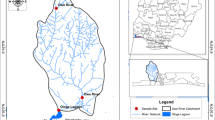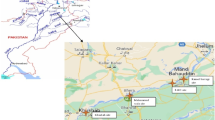Abstract
In the present research, accumulation of Cd, Co, Cr, Cu, Mn, Ni, Pb, V, and Zn were determined in sediments and fillet, liver, kidney, gonads, and gills of three commonly fish species in the largest wetland ecosystem that is located in southwest of Iran; Shadegan wetland. Shadegan is one of the most important wetland that posses various fauna and flora but suffers inputs from agricultural and industrial activities. So, sediment samples and fish species including Barbus grypus, Barbus sharpeyi, and Cyprinus carpio were collected during winter 2009. Results showed that mean concentrations of trace elements (except Ni and Co) were high in liver and gills of B. grypus. Also trace elements had the most accumulation in liver of B. sharpeyi except for Cd (0.26 mg kg − 1 d.w.) and Mn (13.45 mg kg − 1 d.w.) that were high in gills. Beside, kidney is determined as target tissue for Ni and V in B. grypus and for Pb in C. carpio, due to their high concentration. Zn levels in all tissues of C. carpio showed the highest concentrations in comparison to other fish species. Generally, accumulations of most of the studied elements in B. grypus and B. sharpeyi were higher in females than in males, while in fillet and gonads of C. carpio, this trend was inverted. Bioaccumulation factors (BAFs) were determined for different tissues of fish species with respect to elemental concentrations in sediment. BAFs results indicated that Zn, Pb, and Cu have higher BAF than other elements. Also this investigation demonstrated that trace elements have different affinities with condition factor of studied fish species. Gonadosomatic index (GSI) and Pb showed positive correlation together in both B. sharpeyi and B. grypus, respectively, in females and males. Moreover, females of C. carpio showed significantly positive relation of GSI and all studied elements.
Similar content being viewed by others
References
Adjei-Boateng, D., Obirikorang, K. A., & Amisah, S. (2010). Bioaccumulation of heavy metals in the tissue of the clam Galatea paradoxa and sediments from the Volta Estuary, Ghana. International Journal of Environmental Research, 4(3), 533–540.
Alhas, E., Oymak, S. H., & Akin, H. K. (2009). Heavy metal concentrations in two barb, Barbus xanthopterus and Barbus rajanorum mystaceus from Atatürk Dam Lake, Turkey. Environmental Monitoring and Assessment, 148, 11–18.
Amin, O. A., Comoglio, L. I., & Rodriquez, E. M. (2003). Toxicity of cadmium, lead and zinc to larval stages of Lithodes santolla (Decapoda, Anomura). Bulletin of Environmental Contamination and Toxicology, 71, 527–534.
Ashraj, W. (2005). Accumulation of heavy metals in kidney and heart tissues of Epinephelus microdon fish from the Arabian Gulf. Environmental Monitoring and Assessment, 101(1–3), 311–316.
Ayandiran, T. A., Fawole, O. O., Adewoye, S. O., & Ogundiran, M. A. (2009). Bioconcentration of metals in the body muscle and gut of Clarias gariepinus exposed to sublethal concentrations of soap and detergent effluent. Journal of Cell and Animal Biology, 3(8), 113–118.
Bakaç, M., & Kumru, M. N. (2001). Factor analysis in the geochemical studies along the Gediz river, Turkey. Journal of Radioanalytical and Nuclear Chemistry, 249(3), 617–624.
Batzias, A. F., & Siontorou, C. G. (2008). A new scheme for biomonitoring heavy metal concentrations in semi-natural wetlands. Journal of Hazardous Materials, 158(2–3), 340–358.
Brumbaugh, W. G., Schmitt, C. J., & May, T. W. (2005). Concentrations of Cadmium, Lead, and Zinc in fish from mining-influenced waters of Northeastern Oklahoma: Sampling of blood, carcass, and liver for aquatic biomonitoring. Archives of Environmental Contamination and Toxicology, 49, 76–88.
Bu-Olayan, A. H., Al-Hassan, R., Thomas, B. V., & Subrahmanyam, M. N. V. (2001). Impact of trace metals and nutrients levels on phytoplankton from the Kuwait Coast. Environment International, 26, 199–203.
Burger, J. (2007). A framework and methods for incorporating gender-related issues in wildlife risk assessment: Gender-related differences in metal levels and other contaminants as a case study. Environmental Research, 104, 153–162.
Canbek, M., Demir, T. A., Uyanoglu, M., Bayramoglu, G., Emiroglu, O., Arslan, N., et al. (2007). Preliminary assessment of heavy metals in water and some Cyprinidae species from the Porsuk River, Turkey. Journal of Applied Biological Sciences, 1(3), 91–95.
Canli, M., & Atli, G. (2003). The relationships between heavy metal (Cd, Cr, Cu, Fe, Pb, Zn) levels and the size of six Mediterranean fish species. Environmental Pollution, 121, 129–136.
Čelechovská, O., Svobodová, Ž. V., & Macharáèková, B. (2007). Distribution of metals in tissues of the common carp (Cyprinus carpio L.). Acta Veterinaria Brno, 76, S93–S100.
Chester, R., & Hughes, R. M. (1967). A chemical technique for the separation of ferro-manganese minerals, carbonate minerals and adsorbed trace elements from pelagic sediment. Chemical Geology, 2, 249–262.
Dural, M., Ziya Lugal Goksu, M., & Ozak, A. A. (2007). Investigation of heavy metal levels in economically important fish species captured from the Tuzla lagoon. Food Chemistry, 102, 415–421.
Erdoğrul, Ö., & Erbilir, F. (2007). Heavy metal and trace elements in various fish samples from Sır Dam Lake, Kahramanmaraş, Turkey. Environmental Monitoring and Assessment, 130, 373–379.
Fairbrother, A., Wenstel, R., Sappington, S., & Wood, W. (2007). Framework for metals risk assessment. Ecotoxicology and Environmental Safety, 68, 145–227.
Farombi, E. O., Adelowo, O. A., & Ajimoko, Y. R. (2007). Biomarkers of oxidative stress and heavy metal levels asindicators of environmental pollution in African cat fish (Clarias gariepinus) from Nigeria Ogun River. International Journal of Environmental Research and Public Health, 4(2), 158–165.
Feng Li, Y. M., Wen, P., & Zhu, T. (2008). Bioavailability and toxicity of heavy metals in a heavily polluted river, in PRD, China. Bulletin of Environmental Contamination and Toxicology, 81, 90–94.
Fernandes, C., Fontainhas-Fernandes, A., Peixoto, F., & Salgado, M. A. (2007). Bioaccumulation of heavy metals in Liza saliens from the Esmoriz–Paramos coastal lagoon, Portugal. Ecotoxicology and Environmental Safety, 66, 426–431.
Griffiths, S. P., Kuhnert, P. M., Fry, G. F., & Manson, F. J. (2008). Temporal and size-related variation in the diet, consumption rate, and daily ration of mackerel tuna (Euthynnus affinis) in neritic waters of eastern Australia. ICES Journal of Marine Science, 66, 720–733.
Guhathakurta, H., & Kaviraj, A. (2000). Heavy metal concentration in water, sediment, shrimp (Penaeus monodon) and mullet (Liza parsia) in some brackish water ponds of Sunderban, India. Marine Pollution Bulletin, 40, 914–920.
Hendozko, E., Szefer, P., & Warzocha, J. (2010). Heavy metals in Macoma balthica and extractable metals in sediments from the southern Baltic Sea. Ecotoxicology and Environmental Safety, 73, 152–163.
Hosseini Alhashemi, A. S., Karbassi, A. R., Hassanzadeh Kiabi, B., Monavari, S. M., Nabavi, S. M. B., & Sekhavatjou, M. S. (2010). Bioaccumulation of trace elements in trophic levels of wetland plants and waterfowl birds. Biological Trace Element Research. doi:10.1007/s12011-010-8795-x.
Hosseini Alhashemi, A. S., Karbassi, A. R., Hassanzadeh Kiabi, B., Monavari, S. M., & Nabavi, S. M. B. (2011). Accumulation and bioaccessibility of trace elements in wetland sediments. African Joural of Biotechnology, 10(9), 1625–1636.
Karadede, H., & Ünlü, E. (2000). Concentrations of some heavy metals in water, sediment and fish species from the Atatürk Dam Lake (Euphrates), Turkey. Chemosphere, 41, 1371–1376.
Koca, S., Koca, Y. B., Yildiz, S., & Gürcü, B. (2008). Genotoxic and histopathological effects of water pollution on two fish species, Barbus capito pectoralis and Chondrostoma nasus in the Büyük Menderes River, Turkey. Biological Trace Element Research, 122, 276–291.
Kojadinovic, J., Potier, M., Corre, M. L., Cosson, R. P., & Bustamante, P. (2007). Bioaccumulation of trace elements in pelagic fish from the Western Indian Ocean. Environmental Pollution, 146(2), 548–566.
Lombardi, P. E., Peri, S. I., & Verrengia Guerrero, N. R. (2010). Trace metal levels in Prochilodus lineatus collected from the La Plata River, Argentina. Environmental Monitoring and Assessment, 160, 47–59.
Ma, Z., Cai, Y., Li, B., & Chen, J. (2010). Managing wetland habitats for waterbirds: An international perspective. Wetlands, 30, 15–27.
Macfarlane, G. R., & Booth, D. J. (2001). Estuarine macro benthic community structure in the Hawkesbury River, Australia: Relationships with sediment physicochemical and anthropogenic parameters. Environmental Monitoring and Assessment, 72, 51–78.
Mora, S., Fowler, S. W., Wyse, E., & Azemard, S. (2004). Distribution of heavy metals in marine bivalves, fish and coastal sediments in the Gulf and Gulf of Oman. Marine Pollution Bulletin, 49, 410–424.
Murugesan, A. G., Maheswari, S., & Bagirath, G. (2008). Biosorption of cadmium by live and immobilized cells of Spirulina platensis. International Journal of Environmental Research, 2(3), 307–312.
Ozturk, M., Ozozen, G., Minareci, O., & Minareci, E. (2009). Determination of heavy metals in fish, water and sediments of Avsar dam lake in Turkey. Iranian Journal of Environmental Health Science & Engineering, 6, 73–80.
Papagiannis, I., Kagalou, I., Leonardos, J., Petridis, D., & Kalfakakou, V. (2004). Copper and zinc in four freshwater fish species from Lake Pamvotis (Greece). Environment International, 30, 357–362.
Peakall, D., & Burger, J. (2003). Methodologies for assessing exposure to metals: Speciation, bioavailability of metals, and ecological host factors. Ecotoxicology and Environmental Safety, 56, 110–121.
Qiao-qiao, C. H. I., Guang-wei, Z. H. U., & Langdon, A. (2007). Bioaccumulation of heavy metals in fishes from Taihu Lake, China. Journal of Environmental Sciences, 19, 1500–1504.
Rashed, M. N. (2001). Monitoring of environmental heavy metals if fish from Naser Lake. Environment International, 27, 27–33.
Regional Organization for the Protection of the Marine Environment (1999). Manual of Oceanographic Observations and Pollutant Analysis Methods (MOOPAM). Third edition Kuwait: chapter III.
Scott, D. A. (1995). A Directory of wetlands in the Middle East. Limbridge: IUCN and IWRB.
Sekhavatjou, M. S., Rostami, A., & Hoseini Alhashemi, A. (2010). Assessment of elemental concentrations in the urban air (case study: Tehran city). Environmental Monitoring and Assessment, 163, 467–476.
Sekhavatjou, M. S., Hoseini Alhashemi, A., & Rostami, A. (2011). Comparison of trace element concentrations in ambient air of industrial and residential areas in Tehran City. Biological Trace Element Research. doi:10.1007/s12011-011-9001-5.
Taghinia Hejabi, A., Basavarajappa, H. T., Karbassi, A. R., & Monavari, S. M. (2010). Heavy metal pollution in water and sediments in the Kabini River, Karnataka, India. Environmental monitoring and Assessment. doi:10.1007/s10661-010-1854-0.
Tekin-Özan, S., & Kir, I. (2008). Seasonal variations of heavy metals in some organs of carp (Cyprinus carpio L., 1758) from Beyşehir Lake (Turkey). Environmental Monitoring and Assessment, 138, 201–206.
Tessier, A., Campell, P. G. C., & Bisson, M. (1979). Sequential extraction procedure for the speciation of partition of particulate trace metals. Analytical Chemistry, 51, 844–851.
Thomann, R. V., Mahony, J. D., & Mueller, R. (1995). Steady state model of biota—Sediment accumulation factor for metals in two marine bivalves. Environmental Toxicology and Chemistry, 4, 989–998.
United States Environmental Protection Agency (1994). Sediment sampling. SOP#: 2016.
United States Environmental Protection Agency (2000). Guidance for assessing chemical contaminant data for use in fish advisories. Volume 1: Fish Sampling and Analysis Third Edition EPA 823-B-00-008.
Vahter, M., Åkesson, A., Lidén, C., Ceccatelli, S., & Berglund, M. (2007). Gender differences in the disposition and toxicity of metals. Environmental Research, 104, 85–95.
Vinodhini, R., & Narayanan, M. (2009). Heavy metal induced histopathological alterations in selected organs of the Cyprinus carpio L. (Common Carp). International Journal of Environmental Research, 3(1), 95–100.
Vosyliene, M. Z., & Jankaite, A. (2006). Effect of heavy metal model mixture on rainbow trout biological parameters. Ekologija, 4, 12–17.
Wang, W. X. (2002). Interactions of trace metals and different marine food chains. Marine Ecology. Progress Series, 243, 295–309.
West, G. (1990). Methods of assessing ovarian development in fishes—A review. Australian Journal of Marine & Freshwater Research, 41(2), 199–222.
Yılmaz, A. B., & Doğan, M. (2008). Heavy metals in water and in tissues of himri (Carasobarbus luteus) from Orontes (Asi) River, Turkey. Environmental Monitoring and Assessment, 144, 437–444.
Author information
Authors and Affiliations
Corresponding author
Rights and permissions
About this article
Cite this article
Hosseini Alhashemi, A., Karbassi, A., Hassanzadeh Kiabi, B. et al. Bioaccumulation of trace elements in different tissues of three commonly available fish species regarding their gender, gonadosomatic index, and condition factor in a wetland ecosystem. Environ Monit Assess 184, 1865–1878 (2012). https://doi.org/10.1007/s10661-011-2085-8
Received:
Accepted:
Published:
Issue Date:
DOI: https://doi.org/10.1007/s10661-011-2085-8




